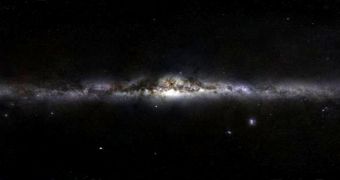The International Year of Astronomy 2009 (IYA2009) saw the launch of numerous projects related to cosmic exploration. One of the most useful is the European Southern Observatory's (ESO) GIGAGALAXY ZOOM project, which aims at creating three amazing, ultra-high-resolution images of the night sky that online stargazers can zoom in on and explore in an incredible level of detail. Most of the photographs comprising the three images were taken from two of ESO’s observing sites in Chile, La Silla and Paranal. The wonderful quality of the images is a testament to the splendor of the night sky at these sites, which are the most productive astronomical observatories in the world.
The recently published image, which can be viewed here, showcases the entire celestial sphere around our planet, and was carefully put together by French astronomers. It represents the result of many years of scientific observations, and also of long hours of hard work. The panoramic view is the result of stitching together 1,200 pictures, organized in 300 fields, each of which was captured four times. The photos were taken between August 2008 and February 2009, from La Silla, Paranal, as well as from the La Palma observatory in the Canary Islands.
ESO collaborated with renowned French writer and astrophotographer Serge Brunier for the new effort. The panoramic view was stitched together using a piece of software called Autopano Pro Giga, and required 340 hours to be put together. “I wanted to show a sky that everyone can relate to – with its constellations, its thousands of stars, with names familiar since childhood, its myths shared by all civilisations since Homo became Sapiens. The image was therefore made as man sees it, with a regular digital camera under the dark skies in the Atacama Desert and on La Palma,” Brunier says.
In the new image, the galaxy is shown edge-on, as if we were observing it from the outside. In this perspective, its spiral nature becomes very obvious, as do its surrounding satellite galaxies. The central bulge of the Milky Way is also shown in great detail, as are glowing nebulae, and areas of stellar formation. The stellar cluster surrounding the black hole at the galactic core is also imaged in great detail. “The vision of the IYA2009 is to help people rediscover their place in the Universe through the day- and night-time sky, and this is exactly what the GigaGalaxy Zoom project is all about,” Henri Boffin, who is the coordinator of the project, concludes.

 14 DAY TRIAL //
14 DAY TRIAL //